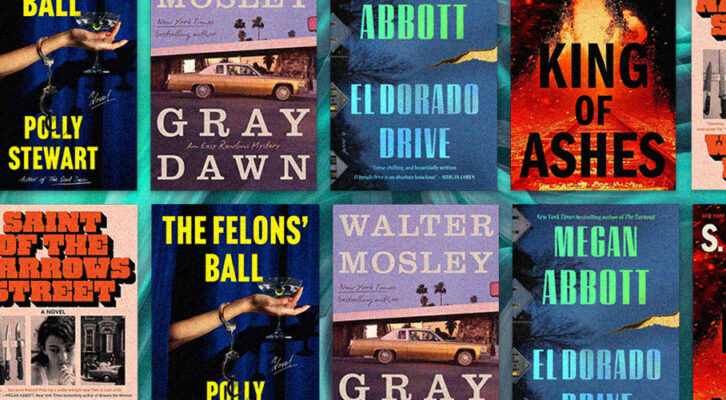
Confessions of a Pugilist: What Mike Tyson Learned from His Mother (and Alexander the Great)
Mark Kriegel on Tyson’s Unstable Childhood, Lorna Mae, and the Fighter’s Historic Obsession
In December 2013, not long after the publication of Mike Tyson’s autobiography, The Wall Street Journal asked him—along with forty‑nine other distinguished writers, academics, artists, politicians, and CEOs—to name their favorite books of the year. Among Tyson’s selections was a Kindle book, Alexander the Great: The Macedonian Who Conquered the World.
“Everyone thinks Alexander was this giant, but he was really a runt,” wrote Tyson, who nevertheless, at the height of his own megalomania, commissioned a seven‑foot likeness of Alexander (along with congruently sized statues of Genghis Khan and the Haitian revolutionary Jean‑Jacques Dessalines) by the pool of his Las Vegas home.
“Alexander, Napoleon, Genghis Khan, even a cold pimp like Iceberg Slim—they were all mama’s boys,” wrote Tyson. “That’s why Alexander kept pushing forward. He didn’t want to have to go home and be dominated by his mother.”
Boxing is permeated with every variety of Oedipal construct. In the last decade or so, the prevalent strain is fighters not merely driven by their fathers but actually trained by them. These dads tend to be street guys who may or may not have boxed themselves. And while the fighter inevitably wants to surpass all paternal expectation, he (or, yes, she) also wants to make Daddy proud. And rich.
Then again, I still see plenty of fighters who just want to kill their fathers, typically for abandonment. Mike might’ve fallen into this category, at least judging from his recollection of Curlee:
He and my mother never spoke to each other, he’d just beep the horn and we’d just go down and meet him. The kids would pile into his Cadillac and we thought we were going on an excursion to Coney Island or Brighton Beach, but he’d just drive around for a few minutes, pull back up to our apartment building, give us some money, give my sister a kiss, and shake me and my brother’s hands and that was it. Maybe I’d see him in another year.
So much for the paternal side of the equation. But it’s the true mama’s boy who seems to me the most dangerous kind of fighter.
Boxing is permeated with every variety of Oedipal construct.
Again, there are a couple of kinds: those who’ve been pampered, those who’ve been provoked, and those who’ve been by turns both babied and baited. The most strategically sadistic fighter I know was an obscure contender when he traveled from his home in Omaha to fight the world champion, a Scotsman, in Glasgow.
“You ain’t shit,” his mother told him, quite pointedly, as he left. “You just gon’ get you ass kicked.”
The fighter in question, Terence Crawford, easily beat the Scotsman for his first of many titles and now, more than a decade later, sits atop boxing’s pound‑for‑pound rankings. Not only does his mother remain a ringside fixture at his fights, but he considers her the wellspring of his greatness.
Apologies. I stray. But you will see a procession of mama’s boys come to share the stage with Tyson. They have but one trait in common: an authentic belief in the self or, if you want to get Macedonian about it, one’s destiny.
Lorna Mae isn’t the source of Tyson’s strength, though, but his vulnerability. Tyson was neither pampered nor provoked. As best I can tell from his own descriptions, he was occasionally upbraided but mostly neglected.
There’s a photograph of Lorna Mae, one of only two that exist in the entire digital universe. Tyson posted it on his Instagram account on June 2, 2020, the day he first saw it. His mother is twenty. The year is 1947. She has full, painted lips. One might call her a handsome woman, as there’s something both sturdy and attractive about her. Statuesque? Perhaps, at five seven.
She’s dressed, too: a saucer‑like chapeau, hoop earrings, a double‑stranded necklace, and a deco‑styled pin on her amply lapeled coat. Apparently, she knew Malcolm X, Miles Davis, and the original Globetrotters. Tyson wrote in the caption: “I’m proud to be the son of Lorna May Smith.”
But his was an unrequited pride and, perhaps more traumatic, an unrequited love.
“Did you ever get the chance,” an interviewer once asked, “to tell her that you loved her?”
“We didn’t have that relationship,” he said.
Tyson’s not always a reliable narrator. None of us are. But he’s revealed, like the rest of us, in the stories he tells himself. The woman in the photograph—the fine, worldly aspiring schoolteacher—is the mother he wanted. But Lorna had limited opportunity, frustrated ambition, and no agency at all.
Twenty years later, Deacon Kirkpatrick would offer something like an explanation. He was working as a construction worker, he said:
I was a little wild back then I think Mike was about two years old. I had a heart attack….When I went into the hospital things changed. I wasn’t able to sup‑ port them. I wasn’t able to do the things I should’ve. And I couldn’t marry her. She just went her way and I went mine. We just split up. All I remember about Mike then was that he was a husky baby.
Why, exactly, Curlee couldn’t marry Lorna is left unsaid. It’s more accurate to say Curlee went his way and Lorna went down. “Straight to hell” doesn’t seem much of an exaggeration. The booze was part of it, a likely symptom at first, and later a cause.
Lorna smoked Kool 100s and threw a lot of parties at the apartment on Quincy Street. There was dope smoking, a lot of drinking (with her eventual boyfriend, Eddie Gillison, she’d water down store‑bought liquor and sell it as shots), and plenty of fornication.
“My mother’s friends were prostitutes,” Tyson would recall, “or at least women who would sleep with men for money.”
When Mike was seven, two years after the House of D had shut its doors, amid a recession and the city’s mounting financial crisis, Lorna and her kids were evicted from their Bed‑Stuy apartment. For a time, she worked as a nurse’s aide.
But their existence became nomadic, each move taking them deeper into Brooklyn and poverty. They slept in their clothes for lack of heat. Fires from adjacent apartments were a constant threat, as tenants or squatters lit them for heat and landlords for the insurance money.
“My mother would do whatever she had to do to keep a roof over our heads,” recalled Tyson. “That often meant sleeping with someone that she didn’t really care for. This is what I hate about myself, what I learned from my mother—there was nothing you wouldn’t do to survive.”
Eventually, they found a place they’d call home, 178 Amboy Street, apartment 2A, in Brownsville. It was built in 1930, when the neighborhood was still occasionally referred to as “Little Jerusalem.” Back then, Brooklyn’s most densely populated community was packed primarily with immigrant Jews, nonunion factories, storefront cheders, and the shtarkers later glorified—branded might now be the preferred term—as Murder, Inc.
But their existence became nomadic, each move taking them deeper into Brooklyn and poverty.
The building was four redbrick stories with fire escapes facing the street, a little three‑step stoop, a tile‑floored vestibule, and an alleyway, a teeming artery of garbage running underneath. As reconstituted in the early seventies, under the auspices of a nonprofit, Colony–South Brooklyn Houses, it was among several adjacent buildings intended to shelter imperiled single mothers.
“Amboy was nice, yo,” recalls Lloyd Daniels, an eventual basketball prodigy, raised next door at 176. “Them was good buildings.”
Apartment 2A was big enough that Rodney, five years Mike’s senior, and Denise, two years older, each had their own rooms. If Mike was “husky,” his siblings were prone to obesity. Rodney, by one account, was two hundred and eighty pounds by age twelve.
A born nerd in Mike’s estimation, Rodney kept a coin collection and an assortment of test tubes and beakers for his science experiments. Nevertheless, he wasn’t above beating Mike’s ass when the urge hit.
Denise was Mike’s favorite. They watched kung fu movies (dubbed Shaw brothers epics like Five Deadly Venoms and The 36th Chamber of Shaolin), wrestling on “the Spanish station,” UHF channel 47 (Mike was partial to Bruno Sammartino, Gorilla Monsoon, and Superstar Billy Graham), and hospital soaps, one of which inspired them to conduct an “operation” on the sleeping Rodney, with Mike slicing into his forearm with a razor. When Rodney came to, Mike hid behind his mother.
He slept in his mother’s bed, too, not that it afforded much in the way of protection. It was a violent household. Lorna’s boyfriend Eddie Gillison wasn’t above smacking her around. Then again, Lorna would smack right back.
Once, Mike tried to intervene. Eddie punched him in the stomach, maybe the first time he went down from a body shot. Anyway, you needed more than a lisping mama’s boy—a “little fairy,” as Mike was already being called on the streets—to subdue Eddie, a stocky guy who worked at an industrial laundry. You needed teamwork—like the time Lorna managed to tackle him to the floor.
Denise and Mike each went at Eddie’s head, beating on him with Rodney’s platform shoes. Rodney’s black lab jumped in, too, taking bites where he could, while Rodney himself beat Eddie around the ankles with a baseball bat.
Still, the incident most frequently recalled began with Eddie knocking out Lorna’s gold tooth, a graduation gift from her father. Mike remained engrossed in wrestling on the Spanish channel as Lorna prepared her retaliatory strike: a pot of boiling water. Mike would recall the slimy blisters that rose from Eddie’s face and neck. Denise tended to Eddie’s wounds. Then Eddie went to the liquor store. A peace offering for Lorna. That’s how it was with them.
“They’d drink, fight, and fuck, break up, then drink, fight, and fuck some more,” Mike would recall.
And if it wasn’t Eddie, it would’ve been another guy.
And maybe little Mike would be in bed alongside her. It happened at least once. Maybe Lorna thought he was sleeping. Or she was just too drunk.
For Mike, it all became part of the same nocturnal soundtrack: “I knew what it was like to hear people scream in the middle of the night, getting mugged. I saw people get shot. I heard my mother get fucked a lot. So I knew about the world.”
I recall apartments like Tyson’s at 178 Amboy, a kind of set piece in the life of a general‑assignment reporter: the smell of fry grease, the piss in the hallways, the water stains, the flaky pipes, the mice. There always seemed to be a little girl oblivious to everything but the cartoons.
You’d express the greatest, most sincere white man’s sorrow to the blankest of faces. Then you’d look through the dead kid’s room. Maybe there’d be a trophy. A cadet badge. A certificate of attendance. Any artifact you could present to an editor on the city desk and argue that the kid had been some kind of honor student.
Then the little girl abruptly turns from her cartoon.
“You know Tupac ain’t dead,” she says. “He in Russia.”
I wonder how a young Alexander the Great would have fared in apartment 2A.
Meanwhile, the dead kid’s mom is eyeing you because she, too, knows about the world.
I wonder how a young Alexander the Great would have fared in apartment 2A.
______________________________

From Baddest Man by Mark Kriegel, published by Penguin Press, an imprint of Penguin Publishing Group, a division of Penguin Random House LLC. Copyright © 2025 by Mark Kriegel.
Mark Kriegel
Mark Kriegel, a former sports columnist for the New York Post and the Daily News, is a boxing analyst and essayist for ESPN. He is the author of Namath: A Biography, Pistol: The Life of Pete Maravich, The Good Son: The Life of Ray "Boom Boom" Mancini, and Baddest Man: The Making of Mike Tyson. He lives in Santa Monica, California, with his wife, the screenwriter Jenny Lumet.



















